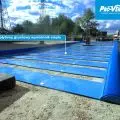The second-largest railroad station in Łódź will undergo a major upgrade. The railroaders have handed over the construction site to the contractor for the work. It will implement the project by the An Archi Group studio from Gliwice.
The first stage of the work will be the construction of a temporary station to serve passengers during the station's reconstruction. The contractor will then proceed with the demolition of the post-modern station building. PKP ensures that the new edifice will be modern, environmentally friendly and adapted to the needs of all passengers.
visualization of the station
© PKP
some of the old in the new
The new building is to retain the spatial layout of the current station, which is divided into three aisles and connected to a new tunnel connecting Włókniarzy Avenue with Lubelska Union Street. The simple, squat body of the station is to be glazed from the square. The facades will be finished in dark oxidized copper, which is expected to ensure durability and require no maintenance work.
interior visualization
© PKP
The skylight in the central part of the building will also be a returning element. Instead of a cylindrical one, however, it will have an irregular, broken shape, to which the interior finishes are also to refer. The first floor of the station will house the part serving travelers, including ticket offices, a spacious waiting room along with a children's area, and commercial premises. On the other hand, the floors of both wings of the building have been allocated for railroad companies.
It is worth noting that as soon as the largest railroad investment in Poland, i.e. the construction of the Łodź cross-town tunnel, is completed, Lódź Kaliska will additionally gain in importance and serve many more travelers than it does now—without the new station this would be impossible, emphasizes Minister of Development and Technology Waldemar Buda.
station square
In addition to the building itself, the immediate surroundings and the station square will also change. Its primary function will be to act as a transportation hub, adapted to the movement of cars (with a place for charging electric cars), buses and bicycles, for which a large shelter has been designed. Behind the building, passenger parking is planned. There will also be a cab rank at the station.
optimization
earlier concept of the station
© PKP
The visualizations of the station, published with the announcement of the start of work , differ slightly from those presented by the Polish State Railways at the tender preparation stage. Instead of orange copper covering the facades, designers opted for gray strips of oxidized metal. The glazings—their shape and size—have also been corrected. Less greenery fills the station's foreground—although this may also be the fault of the choice of shot angle. The biggest changes have occurred on the north side—instead of wide glazing and partial openwork, the visualizations show a massive, dark body.
another version of the station
the first station building from 1902
photo by Włodzimierz Pfeiffer | Public domain—State Archive in Łódź
This is not the first reconstruction of Kaliska Street. The first station building was designed by Czeslaw Domaniewski. Opened in 1902, the building was stylistically in line with Art Nouveau trends. Unfortunately, already in 1914 and then in 1918, the station suffered serious damage during the siege of Łódź and the struggle for the liberation of the city. After the war, it was initially planned to build a new one according to a design by Rudolf Lachert—this one, however, turned out to be too large and expensive to direct. The historic station, which was not under any protection, was finally replaced in 1993 by a postmodern edifice with distinctive turquoise woodwork and crowned with arched glazing, a reinterpretation of the demolished clock tower. Its design was prepared by the team of Jan Gorgul, Marek Skurnóg and Wojciech Garczyński.
The interior of the current station building from 1993
Photo: Zorro2212 | Wikimedia Commons © CC BY-SA 4.0
































